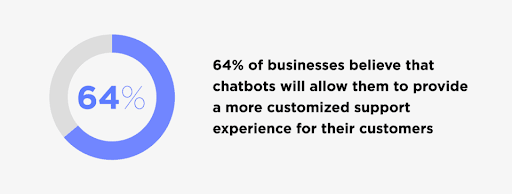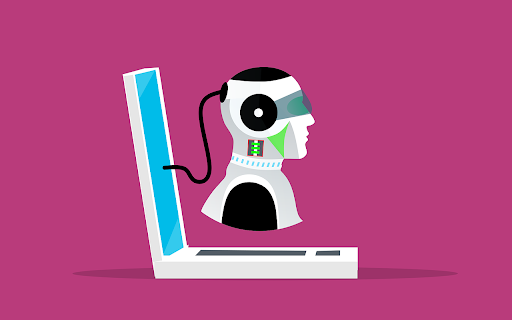Chatbot metrics are crucial when automating customer service. Customers appreciate a personal touch to feel valued, which is hard to achieve with automation. Preset options won’t cater to every customer’s needs.
Chatbots, with the help of AI, are now able to help bridge the gap between personalized service and automated efficiency. This can save a business time and money on contact center costs. As a result, many organizations are incorporating AI contact center software into their KPI Strategies. Wondering “what is a contact center? Well, it’s like a call center just with many other communications channels alongside the traditional phone. Potentially also including chatbots.
Just deploying a chatbot onto your website or social media channels isn’t enough, though. You need to monitor how your chatbot responds to customer queries and highlight any issues. Then, you can refine the behaviors of the chatbot as you go.

Measuring a Chatbot’s Performance
Chatbots can be useful for a variety of customer service and marketing scenarios. You still need to be able to measure their performance, however, just like you would any other technology. There are several key metrics that will help you keep track of chatbot success rates.
This information can be taken from the business data you would ordinarily collect. Any bot-specific information can be monitored by the platform it’s running on. So, you won’t need to expend extra effort and resources sourcing these figures.
There are a number of areas to look at. The most important factor is how the chatbot affects your customer experience. You need to know in which areas the bot best helps customers and any areas where it’s not meeting expectations.
You also need a way to measure your Return On Investment (ROI). Developing a chatbot can incur significant expenses. Even using a third party chatbot option will involve fees. A way to tangibly show the bot’s value to the business lets you know you’re getting value for money.

(Source)
9 Key Metrics For Measuring Chatbot Success
Monitoring KPIs is something you’d do for any department or employee. Think of your chatbot like an employee that can be trained to improve over time. To train the chatbot effectively, you need to measure its performance.
Here are the key areas you need to look at to monitor your chatbot’s success:
1. Engagement Rates
The first thing you need to look at are your engagement rates. That’s how many users are interacting with the bot. This figure shows you the impact of the bot on pure customer numbers. Look at this figure as a percentage of your total user base.
The higher this number is, the more your customers value the services the bot provides. However, on its own, this figure doesn’t tell you a lot about customer satisfaction. You’ll need to break the numbers down further to get these kinds of insights.
2. Total Interactions vs. New Interactions
Another important figure to extract from your user data is the total users divided by new users. Re-engagement is important to monitoring customer satisfaction. If people are returning to your bot for a variety of queries, this suggests they’re happy with the service.
That’s not the only reason this figure is important. If you’re using a chatbot alongside a marketing campaign, then new user spikes would indicate the success of the campaign.
Bringing in new users over time is critical to the health of your business. How your chatbot handles new users will be important to their first impressions of your brand. It’s good practice to keep track of this so you can refine the bot over time.

3. Number of Deflections
Chatbots, cloud contact center software solutions, and other tech tools are designed to improve customer service. So, they’re only successful if they’re reducing the number of customer interactions that need human input.
This is what we mean by deflection. As a figure, this is the number of queries handled by your bot without any human intervention. For example, if you decide to deploy a chatbot to answer FAQs, are customers getting the answers they need?
A chatbot should be able to answer FAQs much faster than a human adviser. If you still have a large number of these queries coming into the contact center, then the bot needs improvement. Mishandled queries can create more work for your human staff.
It’s important that your chatbot can respond to a variety of scenarios. There are always going to be complex issues or complaints that will need human input. The bot should be able to recognize when it cannot handle a query and transfer the customer directly to an adviser.
If you’re involved in contact center operations, then you know that a majority of queries fall into simple categories. This means they can be easily automated. Deflection numbers show you how successful this automation is from your customers’ perspective.
4. Customer Satisfaction Scores
Customer satisfaction is a metric that you would monitor for any service. It’s as important to know your CSAT score for your bot as it is for your human advisers. In fact, comparing these two scores can provide useful insight into how your bot is performing.
When CSAT is much higher for your customer service team than your bot, the bot is not performing to customer expectations. If satisfaction with the bot is significantly higher, then there are issues in your contact center.
You should be looking for similar numbers on both of these scores. As long as the CSAT is acceptable, this means that both units are doing their job.
So, how do you find out how satisfied customers are with your bot? The same way you would for your team. Get feedback from your customers. You can integrate questions about the bot into your current CSAT surveys.
There’s also a simple way to get real-time feedback on bot satisfaction. Include a message at the end of a customers’ interaction with the bot, asking them to give a thumbs-up or down. For more granular information, you could ask for a rating out of five stars.
A simple, one-click action to give feedback will boost feedback engagement rates. You won’t get all the details, but you will be able to gauge how satisfaction changes in real-time.
5. Call Center Handling Times
As we mentioned above, one of the main uses of a chatbot is to help smooth workflow for your customer advisers. When you introduce a chatbot, you should see average call handling times drop.
This is due to the nature of a chatbot. It can handle multiple queries at once and pull up information instantly. As long as the bot has access to the information it needs, it will handle FAQs and orders much faster than an agent.
The other sources for connecting with your clients are using auto dialers for the customer support so that the customer care person can save time and give the maximum energy for converting the clients.
Look at your bot’s handling times, too, to identify any areas where it struggles. You can monitor bot handling times automatically in the same way you do for your advisers. Looking at both figures should also show an overall drop if the bot is performing as needed.

6. Conversion Rates
Chatbot forms are often deployed in social media marketing campaigns. These quick, questionnaire-style forms quickly gauge customer preferences. They can match offers to customers and are a very useful marketing tool. Both for online marketing in general and for more specific areas like website or mobile CVR.
Monitoring conversion rates is the best way to keep track of bot performance in this case. Many chatbot platforms will let you track users through to conversion. You can track how many conversions came through the bot and relate this to the success of your campaign.
7. Lead Generation Figures
Using chatbots to engage customers and generate leads for your sales team is another common use. Tracking the number of leads generated shows how well your bot engages people.
Looking at lead generation figures alongside conversion rates can be especially valuable. With some further analysis of the data, you can see if the leads your bot generates are worthwhile.
Ecommerce stores, retailers, and wholesalers can make use of this. What is wholesale? It’s the larger scale sale of goods to retailers for subsequent sale to consumers.
Ideally, it shouldn’t be difficult to convert the leads that your bot generates. If your sales team consistently struggle to convert these prospects, the bot may be targeting the wrong audience.
8. Unsubscribe/Cancellation Rates
This might not be the most obvious metric to measure. Knowing what marketing campaigns lead to higher customer retention can help you perfect your messaging. This also applies to your chatbots.
When you use a chatbot for a marketing campaign, keep track of how many new users stay with your service. Take note of whether certain messages or campaigns lead to high cancellation rates. You may need to adjust the wording or pursue different opportunities.
9. Development Cost vs ROI
It’s clear that you need to know what your bot is worth to your business. To do this, we need to look at bot costs against revenue, and account for any efficiency savings. This will be heavily dependent on how you source your bot and its intended use.
Developing a bot from scratch is the most expensive way to go about it but gives the highest level of customization. Third-party options are readily available for simple FAQ bots. Managed chatbot options are also available.
AI-driven bots that can interpret text are the highest end of this market, like IBM’s Watson Assistant.
Wrap-Up: Friendly AI
Automated solutions are being embraced in customer service and sales. From auto-dialer software to advanced AI, the technology just keeps improving.
Initial setup costs can be off-putting for some. The potential for increased sales and efficiency savings, though, mean early adopters will see the best returns.

